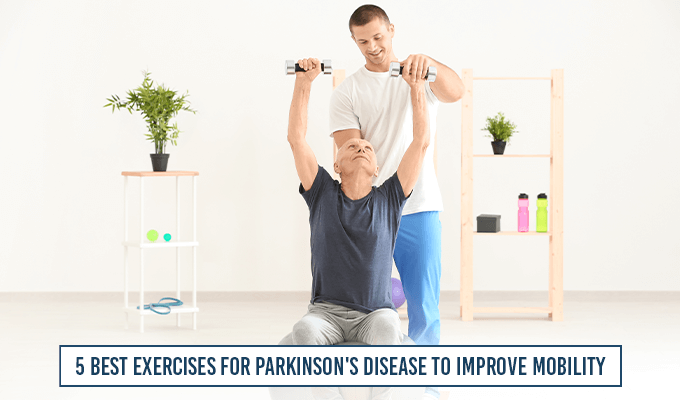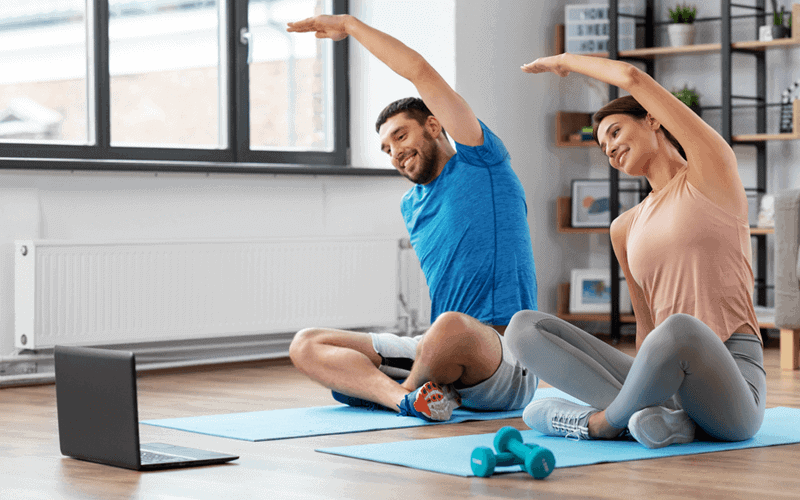5 Best Exercises For Parkinson’s Disease To Improve Mobility

Parkinson’s is a neurodegenerative disease caused by dopamine deficiency; it typically transmits signals to the brain that signal muscles to move fluidly. Restlessness, stiffness, and imbalance are some effects of dopamine deficiency. People suffering from Parkinson’s are lacking dopamine, and their condition can not be reversed entirely, but its symptoms may be controlled or even slowed with exercise.
This guide will present you with the five best exercises for Parkinson’s to enhance your overall physical fitness.
Contents
- Move Stronger, Live Better: Transform Mobility Today!
- A] Why Exercise Matters for Parkinson’s Disease
- B] Types of Exercises for Parkinson’s Disease
- C] Best Exercises for People with Parkinson’s Disease
- D] How to Start Exercising Safely with Parkinson’s
- E] Common Challenges and How to Overcome Them
- Move Stronger, Live Better: Transform Mobility Today!
- Conclusion
A] Why Exercise Matters for Parkinson’s Disease
Exercise and regular physical activity help a person manage the symptoms of Parkinson’s disease. General physical activity reduces stiffness and improves coordination, resulting in increased mobility and fewer falls.
Additionally, exercising has been shown to improve mood, cognitive function, and mental health, which are often affected by Parkinson’s. Other than that, it can also slow the progression of symptoms by encouraging the brain to start developing new pathways so that people can continue maintaining their capabilities. Aerobic workouts and strength training have been found to delay the progression of parkinson’s disease symptoms. Many neurologists and even physical therapists are now prescribing exercise as an important component of the treatment of Parkinson’s disease.
B] Types of Exercises for Parkinson’s Disease
There are many Parkinson’s disease physical exercises that can improve their mobility. Some of them are as follows:
1. Cardio Exercises

Aerobic exercises include running, swimming, cycling, or even walking. These exercises help improve cardiovascular function and increasing endurance. These exercises help the heart pump more efficiently and promote better oxygen flow through the body, which helps reduce fatigue and strengthen general stamina. Research indicates that aerobic exercises can improve the motor and balance ability of people with Parkinson’s.
2. Strength Training

Strength training facilitates counteracting muscle weakness and improves stability, common concerns for people with Parkinson’s. A patient can use free weights, machines, or even bodyweight physical exercises such as squats and lunges to enhance muscle tone and help in all-day tasks that require strength, such as standing up or lifting any object. Strength training can help reduce the risk of falling and enhance stability and coordination in people with Parkinson’s.
3. Light Weight Lifting Or Resistance Bands

Light weights or resistance bands are ideal for muscle building without overstraining the muscles. They help fight stiffness and muscle tremors by increasing flexibility and movement control. Specifically, resistance bands allow the individual to cycle through many controlled movements that could be varied according to the individual’s strength; thus, they are safe and effective for people suffering from Parkinson’s.
4. Balancing Exercises

Balance exercises are integral to preventing falls, which is one of the common issues afflicting people with Parkinson’s. Easy movements such as standing on one leg and shifting the body weight from one leg to another can significantly enhance balance. Incorporating balance exercises for Parkinson’s disease into your regular fitness routine helps strengthen core muscle mass, which plays a key role in maintaining upright posture and preventing stumbles and falls.
5. Flexibility Exercises

Flexibility often deteriorates in people with Parkinson’s, becoming rigid and challenging to move. Flexibility exercises or simple yoga movements can loosen up muscle groups, making it easier for everyday tasks. All people with Parkinson’s disease should include flexibility exercises such as stretching the hamstrings, the shoulders, or the back to enhance their relaxation process and expand their range of movement.
C] Best Exercises for People with Parkinson’s Disease
Here are five best exercises for Parkinson’s disease that are highly recommended:
1. Big Movements [LSVT BIG Program]
The LSVT BIG program is designed for individuals with Parkinson’s. Parkinson’s often causes movement to become slower and smaller, so exercises in this program concentrate on extensive moves like swinging the arms or taking large steps. For instance, marching can help improve your walking pace, balance and coordination. This helps retrain the brain to overcome the restricted movements caused by Parkinson’s.
2. Boxing

Boxing is a popular non-contact activity for people with Parkinson’s disease. There are specially designed programs, like the Rock Steady Boxing, for PD patients. Boxing improves coordination, agility, and strength, as well as hand-eye coordination, which is important for managing tremors and stiffness. For example, shadowboxing or working a punching bag helps stimulate the brain and keep muscle groups active.
3. Chair Yoga

Chair yoga allows people to perform all poses while seated on the chair. Hence itis suitable for individuals with mobility problems. It enhances flexibility and reduces stiffness, which promotes relaxation. Yoga also helps in improving breathing and reducing anxiety, which is commonly seen in Parkinson’s patients. Try seated forward bends or gentle spinal twists loosen the tight muscles and promote flexibility.
4. Dancing
Dancing can improve the balance, coordination, and mood of individuals with Parkinson’s. Specific structured dance classes that include ballroom or tango are the best brain stimulators. Dancing enhances muscle memory and coordination with balance while providing an entertaining, social activity that improves emotional well-being. Opt for ballroom dancing sessions or just dancing to your favourite song are Parkinson’s home exercises, which can help activate the brain and enhance movement.
5. Water-Based Parkinson’s Physical Therapy [Aquatic Therapy]
Water exercises provide a low-impact environment through which one with Parkinson’s can work on strength and flexibility without stressing the joints. The ability to float in water helps making actions easier and less painful. It helps build strength in people with PD. Aqua jogging, water aerobics, or swimming are all great options for enhancing mobility, flexibility, and muscle tone.
While there’s no permanent solution on how to prevent Parkinson’s disease, engaging in these activities can play a role in maintaining overall health and potentially reducing the severity of symptoms over time.
D] How to Start Exercising Safely with Parkinson’s
It’s important to approach exercising competently whilst managing Parkinson’s disease. But here are a few guidelines:
- Consult your doctor or physical therapist before starting any new exercises. They will assess your ability and needs and create a customised treatment plan depenidng on your physical strength.
- Increase the duration of your exercises slowly and gradually. Do not overexert yourself to avoid the risk of injury.
- Choose an activity that you like, such as dancing, yoga, boxing, as long as it’s fun for you. You will now look forward to exercising.
- Find a professional trainer or be part of classes designed specifically for Parkinson’s
- Consider any assistive devices you might need. Walking poles, balance aids, or even chairs can provide exercise stability.
- Always warm up and cool down properly to avoid muscle strain and injury.
E] Common Challenges and How to Overcome Them
People with Parkinson’s regularly face challenging situations like fatigue, stiffness, or fear of falling when it comes to exercising. Here’s how to overcome the most common barriers:
- Divide exercising into shorter sessions in the day to avoid fatigue. For example, instead of a 30-minute exercise, try breaking it up into three 10-minute sessions.
- Focus on gentle, low-effect sporting events, such as yoga or swimming, is easier on the joints and muscle tissue.
- Incorporate mindfulness and breathing exercises to help reduce anxiety and tension throughout the workout.
- Celebrate any small victories, and track your progress to stay motivated.
Conclusion
Exercise is one of the great ways to manage symptoms of Parkinson’s disease. Activities such as boxing, chair yoga, dancing, and water-based exercises can greatly affect how you move and feel daily. These exercises improve your strength, stability, and overall well-being. The secret is to be consistent, and it’s always a great idea to train in front of your healthcare team.
We provide the service as a Personal Fitness Trainer in Mumbai and ensure you follow the right sporting exercises safely and accurately. Eventually, you will notice improvements that make a real impact on your quality of life.

Sudam Shelar
Sudam Shelar is a certified fitness expert and health coach, specializing in personalized training and nutritional guidance for optimal well-being. With a keen focus on dynamic workouts, corrective exercises, and tailored programs, he excels in muscle rehabilitation, personal training, and holistic wellness.


Leave a Reply